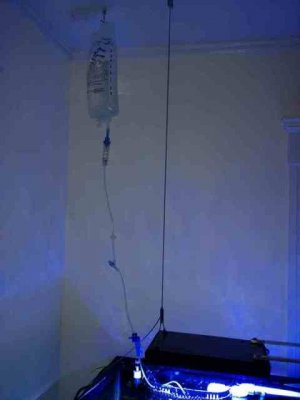Another LaCl3 Reactor Rig-up...
Another LaCl3 Reactor Rig-up...
Okay - so it's been a little while since I've gotten back to this thread, but nonetheless, here's a little rig-up I'm just in the process of tuning up...
Lanthanum Chloride Reactor (Full)
Chamber 3 with Carbon (Precipitate visible)
Feed from Dosing Pump (into suction side of recirc. pump)
So here's a brief summary:
- Total system volume is approx. 900 gallons (550g DT)
- Mag3 pump feeds system from sump via 1/4" polyethylene line
- System water fed in through suction side of eheim 1250 recirc pump attached to first chamber
- Approximately 0.75% - 1.0% dilution of LaCl3 fed into drip (also Tee'd into suction side of recirc pump). Dosing pump runs for 2 mins every 3 hours
- Throughput is approximately 4gph
- Large clear canisters bought from Home Depot; fitted with quick connects
- Last chamber loaded with system carbon to help settle out (passive mechanical filtration) precipitated PO4 fines
- After last (carbon filled) chamber system water is fed directly into Calcium Carbonate Reactor (which consists of two 6" dia x 36" high chambers)
- Effluent from Calcium Carbonate reactor then feeds directly into one of two large beckett driven protein skimmers..
The idea is that 0 phosphate precipitates; and 0 carbon fines should make it back into the system. I've been tuning it for the last few of weeks as I was getting some air infiltration which was stalling the calcium reactor after a few days; however I believe I've tracked this back to not fully resolving the feed into the suction side of the recirc pump... I'll be able to confirm the fixes when I visit this job tomorrow morning.
If I can keep it running without sucking in air (which should be the case now) it looks as though system water is entering in at 0.45ppm PO4 and exiting (prior to skimmer) at 0.03ppm PO4. I should be down to optimal levels within a few weeks.
BTW - this system is very heavily fed with frozen food and coral food rations...
Calcium Reactor
Protein Skimmers
What's key about this system is that I only visit it twice per week so everything has to be on auto-pilot. I have two dosing pumps: the first doses vinegar, and maintains NO3 at 0-2ppm; the second doses LaCl3, and is currently bringing the phosphate down toward a target of 0.03 - 0.05ppm. There are no filter socks on this system at all; in fact, the only mechanical filtration is provided by the pair of large protein skimmers... this LaCl3 phosphate removal system relies completely on slow flow; a long route; and strong protein skimming.
Anyway - that's all for now; hope this helps those of you considering a diy LaCl3 reactor.
Regards,
Sheldon






